


|
 |
|
|
#51 | |
|
Registered Member
Join Date: Dec 2004
Location: Fairbanks, AK
Posts: 1,429
|
Quote:
What did the violets do for you visually? I know a guy locally who said he didn't like the look. |
|
|
|

|
|
|
#52 | |
|
Registered Member
Join Date: Dec 2004
Location: Fairbanks, AK
Posts: 1,429
|
Quote:
Which quantum meter are you using to measure PAR with? The Apogee is notoriously low in the violet-blue region. You need a conversion chart to know what PAR you're really getting. I have the chart. |
|
|
|

|
|
|
#53 | |
|
Reef Guru
Join Date: Jan 2008
Location: the great South
Posts: 3,218
|
Quote:
|
|
|
|

|
|
|
#54 |
|
Zardoz
Join Date: Aug 2005
Location: South
Posts: 1,036
|
I'm running an AI nano over a 20 gallon cube right now. With my blues set to about 80% intensity and my whites around 65% I was getting great color out of a few SPS, but the growth hasn't been crazy. I made a new light hanger which raised my light up from about 6" off the water surface to about 1' off the surface, and then I bumped my power levels up to 100% blues and 85% whites. Within 2 weeks I saw the color in my tricolor sps start to get less intense, and then noticed the bright blues in my other corals went to more of a dull blue. My wife even asked me why the corals weren't as pretty (with no prodding on my part...she had no idea I'd changed things around as she doesn't care that much about the tank).
I then bumped up my whites to 100% and lowered the light another 2". We'll see if they color back up. They don't look "bad" but they don't look as nice as they did before. Would you suggest any supplementation of other colors? |
|
|

|
|
|
#55 | |
|
Registered Member
Join Date: Dec 2004
Location: Fairbanks, AK
Posts: 1,429
|
Quote:
Measure PAR for each blue wavelength LEDs independently, then multiply the PAR reading by the corresponding multiplier below to get the actual PAR. Wavelength: Multiply the Apogee reading by: 400 3.3 410 2.5 420 2 430 1.6 440 1.4 450 1.25 460 1.2 470 1.1 480 1.1 So if you're using 450nm blue LEDs, measure the PAR of the 450s with the Apogee and multiply by 1.25 to get the actual PAR. If you have equal numbers of 450 and 470 blues, you can probably get away with measuring them together and multiplying by 1.2 (the median value for the LEDs between 450 and 470). This method doesn't work with white LEDs because you can't isolate the blue wavelengths from the total spectrum. |
|
|
|

|
|
|
#56 |
|
Registered Member
Join Date: Dec 2004
Location: Fairbanks, AK
Posts: 1,429
|
I think you already know what you should do--add more blues (your choice of wavelength, but some wavelenghts stimulate photosynthesis more than others). You've seen what happens when you decrease PAR by moving them farther away. Light intensity decreases/increases geometrically with distance (the inverse square rule). If anything, it sounds like you need even more of them based on your results, and you need to move them back to the original distance. It sounds like whatever you're using is fine for maintaining health, but isn't quite powerful enough to generate growth. Just curious, how long have you been using the AI? Maybe you're expecting too much too soon?
|
|
|

|
|
|
#57 |
|
Registered Member
Join Date: Apr 2008
Location: S. Scottsdale, AZ
Posts: 2,178
|
The violet (420nm) cleans up the dulling effect on different colors as a result of the predominant blue light. Not sure if that helps. Will have to go back and forth to get a better description of the effect.
|
|
|

|
|
|
#58 | |
|
Zardoz
Join Date: Aug 2005
Location: South
Posts: 1,036
|
Quote:
If I already have RB and B, what other blue spectrum can I add? Edit: Some of the graphs and information you posted is over my head so forgive me if I'm asking questions you've already answered. Last edited by 6Speed; 05/31/2012 at 02:02 PM. |
|
|
|

|
|
|
#59 | |||
|
Registered Member
Join Date: Dec 2004
Location: Fairbanks, AK
Posts: 1,429
|
Quote:
Quote:
Bulbs with higher Kelvin ratings generally had better growth rates; however, growth rates didn't go in Kelvin order (5500, 10000, 14000, 20000). Why? You can also see that the bulbs with more red light emissions had lower growth rates. Growth rates are in Figure 2. Amount of red light emitted is in Figure 5. Now notice that while the 10000K bulb had more blue spectrum than the 5500K and 14000K bulb, it also had the highest output of red light, and the lowest coral growth rate of all 4 bulbs (see Fig 4). So what I'm taking away from that article (and numerous conversations with the author) is that blue is good, and red should not be added. Quote:
Well, there are violets between 400 and 430 you could try. You'll get a good photosynthetic response with a 430nm LED and some additional fluorescent colors, but visually, you might think they look dim because the wavelength is near the edge ov visual detection and because they don't put out many lumens (brightness). You could try cyan. It's not as good for photosynthesis, but it's definitely going to brighten things up visually. It's also good for fluorescence. If you have any questions about what any slide is saying, let me know and I'll explain it differently. Each slide was intended to build on what was presented in preceding slides. Last edited by Crit21; 05/31/2012 at 04:07 PM. |
|||
|
|

|
|
|
#60 |
|
Registered Member
Join Date: May 2006
Location: NC
Posts: 419
|
What height is everyone mounting their LED's? I have a canopy today and would like to utilize that as the framework to hold the fixture. That would put me 12-15" above the water line, I think...
|
|
|

|
|
|
#61 | |
|
Reef Guru
Join Date: Jan 2008
Location: the great South
Posts: 3,218
|
Quote:
|
|
|
|

|
|
|
#62 |
|
Registered Member
Join Date: Dec 2004
Location: Fairbanks, AK
Posts: 1,429
|
Farther from the water means you'll need narrower beam lenses to focus the light.
|
|
|

|
|
|
#63 |
|
Registered Member
Join Date: May 2006
Location: NC
Posts: 419
|
Yep, I was thinking 60 deg optics. This is the layout I'm thinking about with the dashed blue lines representing the light cones at the water surface based on my measured height. This isn't all of them, but a few just to check coverage...
 This is the layout for each "pod" that I'm looking at doing... 
|
|
|

|
|
|
#64 |
|
Fish Freak
Join Date: Aug 2009
Location: Spring Hill, FL
Posts: 1,136
|
Crit,
The local guy didnt like the reds, not violets. I have 3 AI SOL blues and ran them exclusively for a bit over a year over my 125. I have a mixed reef with lps, sps, zoas, etc. To me the whole tank had a cold or sterile look to it. Corals were growing good but it just didnt look inviting. I also struggled with reds, pinks and purples in my tank. They just didnt have the richness like I have seen with halides. I built 2 DIY fixtures to go in between my SOL's which house 14 True Violets (390nm-430nm), 5 Turquoise (495nm) and 5 Deep Red (660nm) per fixture. 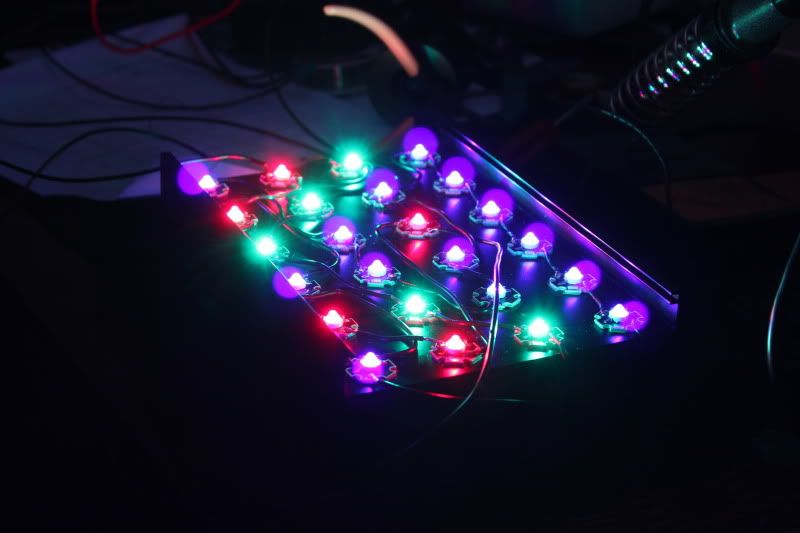 I didn't get the fixture up until 04/01/2012 so I cant really comment on growth yet. However the additional spectrum is amazing! The tank looks so much more rich in color, not at cold and has a much warmer, inviting feeling to it. My bleached looking reds are now rich and dark, pinks are nice and vibrant and purples are really starting to come around. Crit is on the same local forums as I and he scared me out of running the reds, lol. I currently only run the turquoise and violets and so far I am very pleased and glad I added more spectrum. The only time I run the reds is late at night if I want to get in some nighttime viewing, otherwise they are always off. 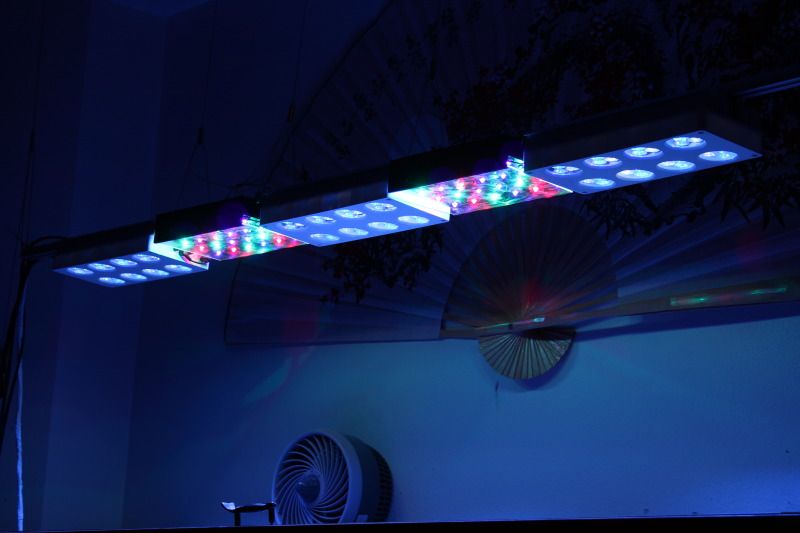 Violets really really make things pop but like stated, they are very dim. I have 28 of them over my 125 with 60 degree optics and they are washed out by any and all other light. You cant really see the difference unless other lights are off or near off. Anything above 5% for any other color and they just blend in. Adding the supplemental lighting gave me the missing piece to the puzzle. I now get the pop that blue leds are well known for and the added colors give my tank the warmth that halides are known for. Nothing scientific, just my observations with my system and running LED's exclusively for almost 2 years.
__________________
Kris - 200 Gallon Baby Reef Current Tank Info: 225 Upgrade Setup 11/17/2012 72x27x27 - Custom 40g sump/Diablo DCS-250int skimmer/Blueline HD40x/2 MP40's/Tunze ATO/2 Part/BRS RODI/ Neptune apex, WXM/3 Radium 250w Galaxy Ballast/8 39w T5's/Litermeter III/Aquavitro Salinity/20%WC/Carbon/GFO/Vinegar |
|
|

|
|
|
#65 |
|
Registered Member
Join Date: Dec 2004
Location: Fairbanks, AK
Posts: 1,429
|
Last edited by Crit21; 05/31/2012 at 09:15 PM. |
|
|

|
|
|
#66 |
|
Registered Member
Join Date: Dec 2004
Location: Fairbanks, AK
Posts: 1,429
|
As promised. This is the pocillopora meandrina that turned from brown to purple and started growing like crazy. The first pic is the poci shortly after I added the LEDs. It's brown, but you can see new growth just starting. The second one several months is after I switched to the LEDs. The little blue and purple bumps are massive new growth. Notice the color change.
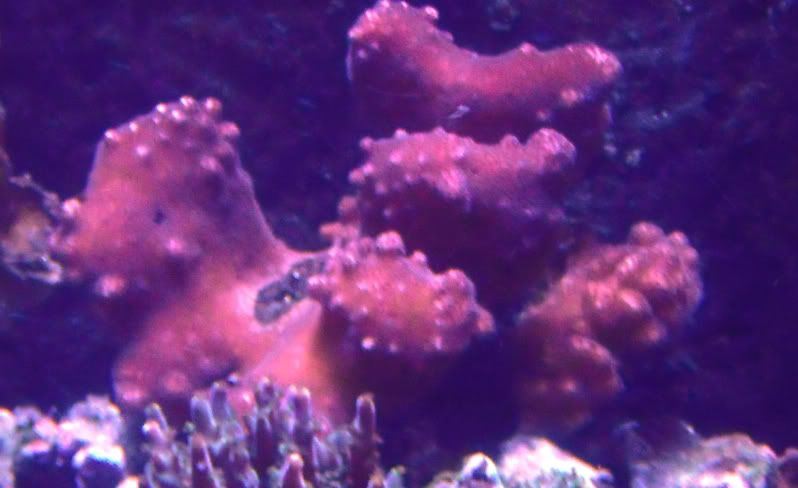 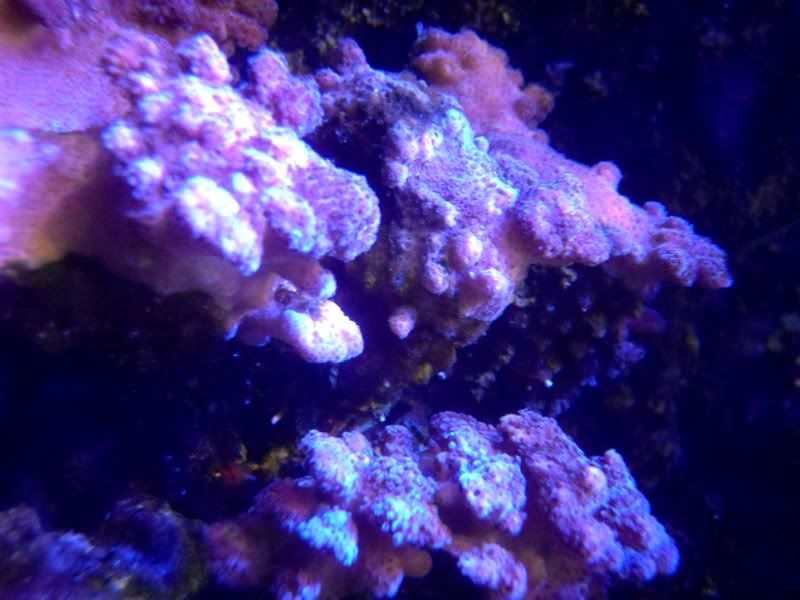
Last edited by Crit21; 05/31/2012 at 09:29 PM. |
|
|

|
|
|
#67 |
|
Registered Member
Join Date: May 2006
Location: NC
Posts: 419
|
djkms, nice info. A couple of things...
You have a lot of different color LED's on the DIY fixtures, do you see any color banding? It looks like you have the fixture mounted high above the tank? What is the height? Also, it doesn't look like you are using optics? I'm wondering if these factors affect the color banding? Another good data point on the additional colors being a benefit... |
|
|

|
|
|
#68 | |||
|
Fish Freak
Join Date: Aug 2009
Location: Spring Hill, FL
Posts: 1,136
|
Quote:
^^ Quote:
Quote:
__________________
Kris - 200 Gallon Baby Reef Current Tank Info: 225 Upgrade Setup 11/17/2012 72x27x27 - Custom 40g sump/Diablo DCS-250int skimmer/Blueline HD40x/2 MP40's/Tunze ATO/2 Part/BRS RODI/ Neptune apex, WXM/3 Radium 250w Galaxy Ballast/8 39w T5's/Litermeter III/Aquavitro Salinity/20%WC/Carbon/GFO/Vinegar |
|||
|
|

|
|
|
#69 |
|
Registered Member
Join Date: Dec 2004
Location: Fairbanks, AK
Posts: 1,429
|
Ah, ok. A guy here in Colorado Springs said he didn't like the look when he added violet LEDs. I'd like to see for myself.
|
|
|

|
|
|
#70 |
|
Premium Member
 Join Date: Mar 2002
Location: Orange County, CA
Posts: 4,629
|
Ok I don't want to rain on anyone's parade, because I really like this thread, but there are a LOT of assumptions in the initial write-up.
I think one of the things that bothers me most is summed up by the first slide and the comment about "experiences snorkeling in Hawaii". I like Hawaii (been there 10+ times), but don’t think for a second that conditions in Hawaii (central pacific) mirror those of the south or eastern pacific. Hawaii is a solitary seamount in the middle of a large cold ocean. It’s biodiversity is extremely low. There are only about 70 species of stony corals recorded in Hawaiian Islands down through diving depth, and they are mostly plating and thick branching corals. Compare that to about 600 species of stony corals in New Guinea. Conditions in Hawaii (no fringe reef, cold water, pounding waves) are very different from conditions under which most ornamental corals are collected in other parts of the world, and entire families of corals are missing from the islands. So when the slides go on to try to analyze "optimal" lighting for corals based on "average collection depth" I think the entire approach starts to get really shaky. Different corals require different light. They are found at different depths in nature. They are collected from different depths. A shallow water table acropora is going to have very different lighting requirements than a deep water plating montipora. To try to take an "average" may not be providing the best lighting solution for either species. (To say nothing about collecting tridacnids from 60ft of water... they are CITES protected and wild collection for export is banned in all countries other than Vietnam - almost all tridacnids come from farms and are raised in less than 12" of water) I think a better approach, instead of relying on assumptions and guesstimates, is to target a specific biotope and say you are trying to recreate those conditions artificially. Want a deep water monti tank? Great - be prepared to go very blue. Want a shallow water table acro tank? I believe you will come up with a very different lighting solution. I KNOW the OP listed his approach is being limited because of the "one size fits all" approach, but without a specific target in mind, all other lighting analysis is just guesswork.
__________________
"You are a very fine person, Mr. Baggins, and I am very fond of you; but you are only quite a little fellow in a wide world after all!" - The Hobbit; J. R. R. Tolkien |
|
|

|
|
|
#71 |
|
Registered Member
Join Date: May 2006
Location: NC
Posts: 419
|
djkms, thanks! That's about my situation, 14" AWL & I was planning on 60deg optics. If all works well, then no diffuser, if possible...easy to add if I need it...but hoping to avoid it.
|
|
|

|
|
|
#72 |
|
Premium Member
 Join Date: Mar 2002
Location: Orange County, CA
Posts: 4,629
|
Another consideration is the assumption that a coral's lighting requirements are fixed. They are not. Photosynthetic corals can shuffle zooxanthellae clades to adjust for changes in environment. A coral in one person's tank may take on a very different appearance in another person's tank once it has had time to adjust/adapt to the conditions. Coral pigmentation will adjust/adapt based on factors SEPARATE from factors that impact photosynthesis. Therefore, if you focus on maximizing PUR you may end up with a tank full of super healthy corals that are all brown. The zooxanthellae is rockin' but the spectral intensities are not present for rich pigmentation development.
__________________
"You are a very fine person, Mr. Baggins, and I am very fond of you; but you are only quite a little fellow in a wide world after all!" - The Hobbit; J. R. R. Tolkien |
|
|

|
|
|
#73 |
|
Registered Member
Join Date: Dec 2004
Location: Fairbanks, AK
Posts: 1,429
|
It's good to see a critical view. I think you skipped over a lot of material in the slides and concluded that I made assumptions that I had not. What I did do was to find enough valid information on which to base my own lighting choices. It's so much better than the "let's try some green, red and UV LEDs and see what happens" approach that even LED manufacturers are taking.
My experiences in Hawaii were a jumping off point. It was a single observation about the depths at which corals grow--some shallow, and some deep, each with different light environments. It had nothing to do with currents, temperature, or anything else non-light related. The data I found regarding coral collection depths were not for Hawaiian corals, but for corals available in the trade, meaning corals collected world-wide. In fact, none of the collection depths were for Hawaiian corals at all. Coral collection for commercial purposes in Hawaii has been illegal for over a decade. Optimal lighting? You echoed the point I made on the 4th slide. "This will be a one-solution-fits-all scenario. I realize that drawing conclusions about wavelengths and intensities over a large depth range may be an over-simplification, but since aquariums are limited to a single lighting system for the entire tank, I have no choice." Unless you get corals with tags that specify their collection depth, you're always "guesstimating". My point was that since 99% of hobbyists have a mixed tank--myself included--the best approach is the middle ground. I have no intent to have a tank limited to just deep water or shallow water corals--really limiting IMO. My goal is to strike a balance where I can grow pretty much anything I want. |
|
|

|
|
|
#74 | |
|
Registered Member
Join Date: Dec 2004
Location: Fairbanks, AK
Posts: 1,429
|
Quote:
AdvancedAquarist has published several good articles on coral pigmentation. Dana Riddle's going to be speaking in SF soon on that very subject. I'm looking forward to seeing the presentation. Last edited by Crit21; 05/31/2012 at 10:49 PM. |
|
|
|

|
|
|
#75 |
|
Registered Member
Join Date: Dec 2004
Location: Fairbanks, AK
Posts: 1,429
|
Here's an example of what you can tell from lighting from just snorkeling. Guess which one was in shallow water?
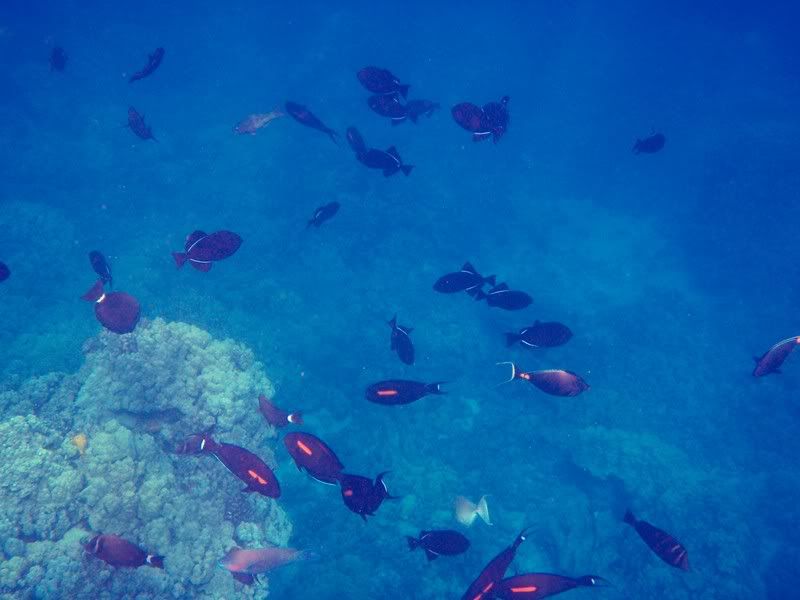 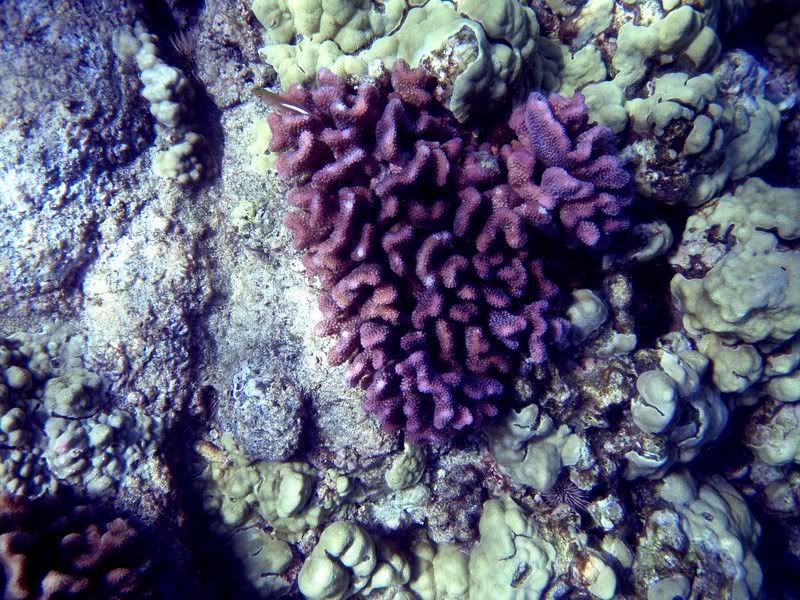
|
|
|

|
 |
|
|